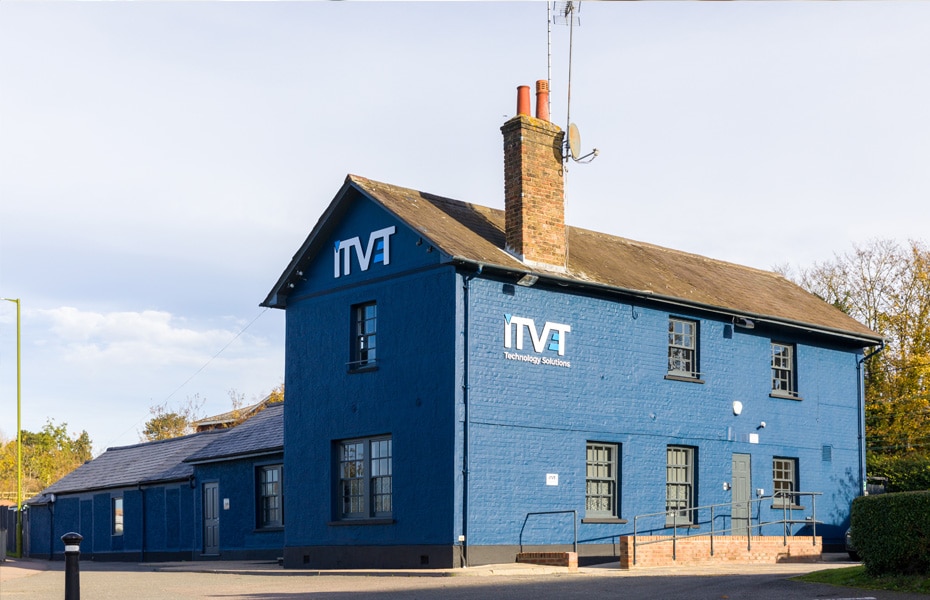Enter your email address to receive the latest ITVET news, market insights, and useful IT tips.
In a digital-first world, technology underpins almost every aspect of business – but this comes at a cost. The IT industry now accounts for up to 3% of global carbon emissions – rivalling aviation.
With mounting pressure from regulators, customers, investors, and employees, businesses must act right now and embrace sustainable IT practices. Done right, green IT reduces your environmental impact without compromising performance, security, or innovation.
In this article, we outline practical strategies to make your IT operations more sustainable and how ITVET can support your journey to a greener, more resilient technology infrastructure.
What is sustainable IT?
Sustainable IT involves designing, implementing, and managing information technology systems in ways that minimise their environmental impact. It covers the entire lifecycle of your IT assets, from procurement and usage to maintenance and disposal, ensuring sustainability is embedded at every stage. Sustainable IT practices generally focus on reducing energy consumption, lowering carbon emissions, and responsibly managing electronic waste. By adopting this greener approach, businesses can significantly reduce the carbon footprint of their IT operations while maintaining efficiency and driving long-term value.
Why is it important for businesses to be sustainable?
Whether you’re managing office IT or overseeing integrated technologies across commercial properties, sustainable IT delivers benefits beyond environmental responsibility.
Here are the key benefits:
Environmental benefits
Every step toward IT sustainability contributes to broader climate goals and accelerates the transition to net zero. By reducing energy consumption, cutting carbon emissions, and managing e-waste responsibly, businesses can actively help protect the planet.
Lower operational costs
Going green isn’t just ethically sound – it also makes strong financial sense. Sustainable IT practices can deliver significant cost savings by reducing energy consumption, lowering operational expenses, and enabling smarter procurement decisions.
Enhanced brand reputation
Today’s customers, partners, and investors increasingly expect organisations to demonstrate environmental responsibility. By committing to eco-friendly IT, your business can strengthen trust, boost loyalty, and differentiate itself in a competitive market.
Regulatory compliance
The UK government is tightening sustainability regulations. By integrating sustainable IT, businesses can comply with these rules, meet ambitious targets, avoid potential penalties, and future-proof their operations in a rapidly evolving legal landscape.
Future-proofing your business
Sustainable IT is a key driver of long-term growth, efficiency, and innovation. By aligning your IT strategy with environmental, social, and governance (ESG) goals, your organisation can build greater resilience and stay competitive in a rapidly evolving business landscape.
8 Green IT practices to reduce your environmental impact
1. Optimise energy efficiency in IT infrastructure
Energy consumption is one of the biggest environmental costs in IT. From powering servers to cooling hardware, inefficient systems waste both energy and money. PwC research shows 89% of UK businesses increased their energy consumption in the past year, with 34% of them citing technology as the main driver.
– Switch to energy-efficient hardware
Start by auditing your existing IT equipment. Replace outdated servers, computers, and networking devices with modern, energy-efficient alternatives. Look for devices that come from suppliers with strong environmental credentials, such as ISO 14001 certification.
– Consolidate your devices
Reduce your energy footprint by replacing multiple single-function machines with energy-efficient multi-function alternatives such as all-in-one printers that handle printing, scanning, and copying. Consolidating equipment minimises redundancy, streamlines office workflows, cuts power consumption, and reduces maintenance demands.
– Move to the cloud
Migrating to cloud platforms can significantly reduce your organisation’s energy usage and carbon footprint. By consolidating workloads and eliminating the need for power-hungry on-site servers, cloud computing supports greater efficiency. Choosing providers powered by renewable energy, like Microsoft Azure, further enhances your sustainability impact.
– Automate power management
Power management is a simple yet powerful way to reduce energy consumption across your IT infrastructure. By automating energy-saving settings, such as powering down monitors, hard drives, and other peripherals after periods of inactivity, you can significantly lower electricity usage while maintaining productivity.
2. Adopt sustainable data management
Data is the backbone of every modern business, but storing and processing data consumes vast resources. Efficient data management is vital for any eco-friendly IT strategy.
– Manage data lifecycles effectively
Not all data needs to be kept indefinitely. We can help you implement policies to regularly archive or delete redundant, obsolete, or trivial (ROT) data. Adopting this practice reduces storage requirements and improves system performance.
– Choose green data centres
Choose green data centres powered by renewable energy. Many leading providers operate carbon-neutral facilities and utilise advanced cooling systems to reduce emissions significantly.
3. Reduce e-waste through responsible lifecycle management
E-waste is an escalating global problem. The UK generates around 1.6 million tonnes of e‑waste annually, placing it among the largest producers per capita globally. Discarded electronics pollute our planet and contain hazardous materials that pose serious environmental and health risks. Businesses have a responsibility to manage hardware lifecycles sustainably, minimising harm and promoting a circular economy.
– Extend equipment lifespan
Regular maintenance, timely upgrades, and proper handling help extend the lifespan of IT assets. At ITVET, we support clients with proactive monitoring and ongoing support to help you maximise the value and performance of your systems.
– Ensure ethical disposal and recycling
When devices reach end-of-life, they must be disposed of responsibly. At ITVET, we partner with CDL, a certified e-waste recycling company, to guarantee environmentally safe processing and responsible materials recovery, fully compliant with WEEE regulations.
– Promote refurbishment and reuse
Consider donating or repurposing equipment that is still functional, extending its life and supporting circular economy principles. At ITVET, we actively champion the circular economy through our Laptops for Schools initiative. This scheme enables organisations to donate refurbished devices to schools, prolonging the lifecycle of their equipment while supporting digital inclusion.
4. Promote greener software and digital practices
Sustainability isn’t just about hardware – software choices and digital habits also have a significant impact.
– Choose lightweight applications
Heavy, bloated software increases power consumption. Opt for lightweight, cloud-native applications that demand less processing power.
– Optimise code and systems
Efficient, well-written code runs faster and uses fewer resources. Regularly review and optimise your systems to eliminate wasteful processes.
– Promote digital sustainability
Encourage employees to adopt sustainable digital habits, such as turning off unused devices, avoiding unnecessary printing, and using dark mode where appropriate.
5. Leverage smart technologies
Smart technology plays a pivotal role in sustainable IT, enabling more efficient control of energy, lighting, heating, and cooling systems. Intelligent building management systems (BMS) and IoT devices monitor usage patterns and automatically adjust settings to minimise waste without compromising comfort or productivity. These solutions can significantly reduce carbon emissions, lower operational costs, and enhance the occupant experience.
This is particularly beneficial in commercial properties with complex infrastructure – a space where ITVET specialises. We work closely with leading property management companies, such as Savills, The Crown Estate, Hammerson, and JLL, to deliver smart, sustainable solutions. Our smart building consultancy team plans and implements intelligent technologies aligned with your sustainability goals, ensuring seamless integration with your existing infrastructure.
6. Implement sustainable procurement and partnerships
Every technology choice has an environmental impact. Align your supply chain and procurement practices with your sustainability goals.
– Evaluate vendors on sustainability
Work with suppliers who demonstrate environmental responsibility. Look for certifications, such as ISO 14001 certification, and evidence of sustainable sourcing. ITVET partners exclusively with suppliers who share our commitment to sustainability, ensuring that every layer of your IT ecosystem supports your green credentials.
– Develop sustainable IT policies
Embed sustainability in your IT governance with clear procurement, usage, and disposal policies. Support these policies with employee training on sustainable practices and monitor progress through regular reviews and reporting.
7. Offset carbon emissions and support green initiatives
Even the most efficient IT strategies can leave a residual carbon footprint. Carbon offsetting offers a practical way to balance these emissions by investing in environmental projects that restore ecosystems and generate renewable energy.
At ITVET, we take responsibility for our environmental footprint. We’re proud to partner with Tree-Nation, a global reforestation platform that helps businesses plant trees and offset CO₂ emissions. Through this partnership, we’ve supported vital projects in Madagascar and Tanzania that combat climate change, protect biodiversity, and empower local communities. Backing initiatives like these strengthens your environmental credentials and contributes to a healthier, more sustainable planet.
8. Measuring and reporting sustainability impact
You can’t improve what you don’t measure. Make sure your IT department plays an active role in driving and contributing to your organisation’s wider sustainability reporting.
– Track key sustainability metrics
Implement tracking tools and sustainability dashboards to monitor key metrics, such as energy consumption, carbon emissions, and e-waste volumes. These tools provide clear visibility into your progress and help identify opportunities for further improvement.
– Provide transparent reporting
Accurate and transparent reporting helps you meet regulatory requirements and demonstrate progress on ESG commitments. It also provides valuable insights for stakeholders and investors, helping to inform decisions and build trust.
Challenges of implementing sustainable IT
While the benefits of sustainable IT practices are clear, the journey towards greener infrastructure isn’t without its obstacles. Many businesses, particularly SMEs, face challenges that can slow down or complicate progress.
Common hurdles include:
- Budget constraints
Upfront investment in greener hardware or systems can feel costly. However, the long-term savings in energy and maintenance far outweigh the initial expense. - Legacy systems
Older IT systems may not support energy-efficient operations or be compatible with newer green technologies. Replacing or upgrading them without disrupting workflows requires expert planning. - Lack of internal expertise
Many organisations lack in-house knowledge of IT sustainability practices, making it difficult to assess environmental impact or know where to start. - Supplier limitations
Not all technology suppliers prioritise sustainability. Businesses may struggle to find eco-conscious partners or feel locked into existing contracts. - Change management
Adopting green IT practices often requires changes in company culture and employee behaviour, which can be difficult without strong internal communication and leadership.
How ITVET can help you achieve your sustainability goals
At ITVET, we know that transitioning to sustainable IT can be challenging – but with the right partner, it’s entirely achievable. We combine technical expertise with a practical, results-driven approach to help your business build a greener, smarter IT infrastructure that supports both growth and environmental responsibility.
Our team works closely with you to:
At ITVET, we know that transitioning to sustainable IT can be challenging – but with the right partner, it’s entirely achievable. We combine technical expertise with a practical, results-driven approach to help your business build a greener, smarter IT infrastructure that supports both growth and environmental responsibility.
Our team works closely with you to:
- Develop a customised sustainability roadmap aligned with your goals and budget, covering:
- Cloud migration to reduce reliance on energy-intensive infrastructure
- Optimising legacy systems for improved energy efficiency
- Implementing smart building technologies to cut emissions
- Managing device lifecycles to minimise waste and extend longevity
- Advise on selecting eco-conscious vendors and applying industry best practices
- Train your teams to adopt sustainable digital habits across the organisation
- Track and report measurable outcomes, including reductions in carbon emissions
By partnering with ITVET, you’ll transform sustainability from a goal into a practical, profitable reality – driving long-term savings and freeing up resources for innovation and growth.

ITVET: Your partner in sustainable IT
Sustainability in IT is no longer optional – it’s essential for future-proofing your business and staying competitive. By embracing sustainable IT practices, your organisation can reduce costs, lower carbon emissions, and build resilient and efficient technology infrastructure.
Whether you’re managing office-based systems or complex technologies across commercial properties, ITVET is here to guide you every step of the way. As a leading technology solutions provider, we’re committed to helping businesses across the UK reduce their environmental impact while driving meaningful business value. We specialise in delivering managed IT services, smart building technologies, and green cloud solutions – all designed with sustainability at their heart.
Ready to make your IT more sustainable? Contact us today and discover how we can help transform your technology for a greener future.





